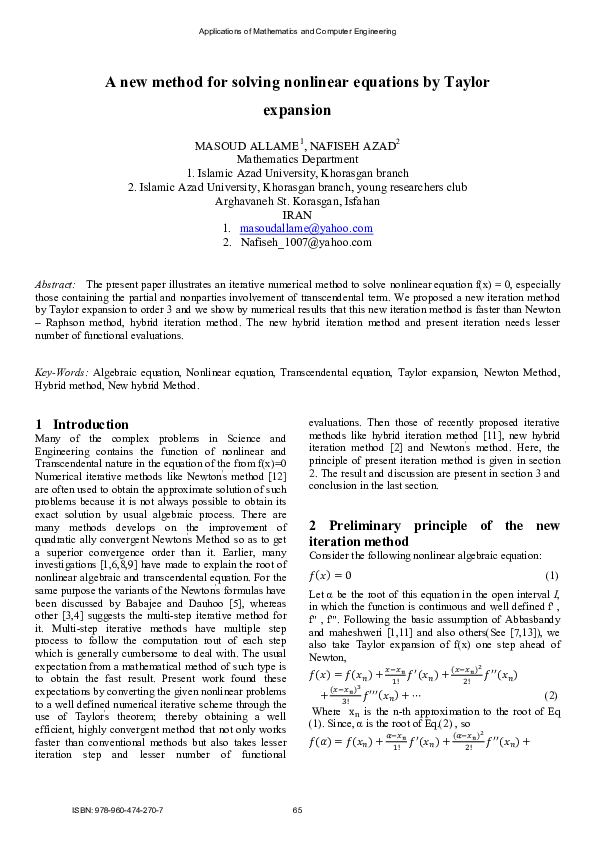Academia.edu no longer supports Internet Explorer.
To browse Academia.edu and the wider internet faster and more securely, please take a few seconds to upgrade your browser.
A new method for solving nonlinear equations by Taylor expansion
A new method for solving nonlinear equations by Taylor expansion
Related Papers
The aim of this paper is to construct an efficient iterative method to solve non linear equations. One new iterative method for solving algebraic and transcendental equations is presented using a Taylor series formula . using the , the Newton’s method and the an Improve iterative method and the result compared. It was observed that the Newton method required more number of iteration in comparison to improve iterative method. By the use of numerical experiments to show that this method are more efficient than Newton – Raphson method.
2016 •
In this paper we introduce, numerical study of some iterative methods for solving non linear equations. Many iterative methods for solving algebraic and transcendental equations is presented by the different formulae. Using bisection method , secant method and the Newton's iterative method and their results are compared. The software, matlab 2009a was used to find the root of the function for the interval [0,1]. Numerical rate of convergence of root has been found in each calculation. It was observed that the Bisection method converges at the 47 iteration while Newton and Secant methods converge to the exact root of 0.36042170296032 with error level at the 4th and 5th iteration respectively. It was also observed that the Newton method required less number of iteration in comparison to that of secant method. However, when we compare performance, we must compare both cost and speed of convergence [6]. It was then concluded that of the three methods considered, Secant method is the most effective scheme. By the use of numerical experiments to show that secant method are more efficient than others.
In this paper, we present a new third-order iterative method for solving nonlinear equations. The new method is based on Newton-Raphson method and Taylor series method. The efficiency of the method is tested on several numerical examples. It is observed that the method is comparable with the well-known existing methods and in many cases gives better results.
In this paper, we present new one- and two-steps iterative methods for solving nonlinear equation f(x)=0. It is proved here that the iterative methods converge of order three and six respectively. Several numerical examples are given to illustrate the performance and to show that the iterative methods in this paper give better result than the compared methods
Solving the root of algebraic and transcendental nonlinear equation f (x) = 0 is a classical problem which has many interesting applications in computational mathematics and various branches of science and engineering. This paper examines the quadratic convergence iterative algorithms for solving a single root nonlinear equation which depends on the Taylor's series and backward difference method. It is shown that the proposed iterative algorithms converge quadratically. In order to justify the results and graphs of quadratic convergence iterative algorithms, C++/MATLAB and EXCELL are used. The efficiency of the proposed iterative algorithms in comparison with Newton Raphson method and Steffensen method is illustrated via examples. Newton Raphson method fails if f (x) = 0, whereas Steffensen method fails if the initial guess is not close enough to the actual solution. Furthermore, there are several other numerical methods which contain drawbacks and possess large number of evolution; however, the developed iterated algorithms are good in these conditions. It is found out that the quadratic convergence iterative algorithms are good achievement in the field of research for computing a single root of nonlinear equations.
Applied Mathematics and Computation
A new hybrid iteration method for solving algebraic equations2008 •
Open Journal of Mathematical Analysis
A New Third-Order Iteration Method for Solving Nonlinear EquationsInternational Journal of Theoretical and Applied Mathematics
Comparison of Some Iterative Methods of Solving Nonlinear Equations2018 •
RELATED PAPERS
International Journal of Science, Technology, Engineering and Mathematics
Eating Habits, Nutrition Literacy, and Mathematics Performance of Junior High School Students2023 •
IOER International Multidisciplinary Research Journal
MODULAR LEARNING EFFICIENCY: LEARNER'S ATTITUDE AND PERFORMANCE TOWARDS SELF-LEARNING MODULES2023 •
2011 •
Journal of Forestry Research
Disentangling the effects of management and climate change on habitat suitability for saproxylic species in boreal forests2024 •
International Journal of Healthcare Information Systems and Informatics
A Software Tool for Reading DICOM Directory Files2007 •
2004 •
Journal of Pharmacological Sciences
N-Methyl-D-aspartate Induces Phosphorylation of cAMP Response Element (CRE)-Binding Protein and Increases DNA-Binding Activity of CRE in Rat Retina2004 •
Nucleic Acids Research
Growth-regulated expression and G0-specific turnover of the mRNA that encodes URH49, a mammalian DExH/D box protein that is highly related to the mRNA export protein UAP562004 •
Philippiniana Sacra
Theological Constants of Justice in Catholic Social Teaching2008 •
International Journal of Fuzzy System Applications
A Brief Review and Future Outline on Decision Making Using Fuzzy Soft Set2018 •
RELATED TOPICS
- Find new research papers in:
- Physics
- Chemistry
- Biology
- Health Sciences
- Ecology
- Earth Sciences
- Cognitive Science
- Mathematics
- Computer Science

 a a
a a